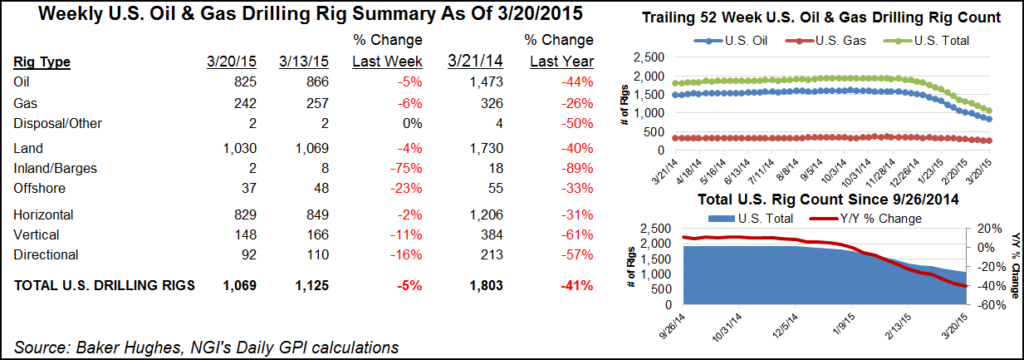U.S. Rig Decline Pace Quickened Slightly
The decline in U.S. rigs on a year/year basis gained momentum, as evidenced by the most recent Baker Hughes Inc. rig count. The total U.S. rig count fell 41% year/year for the week ending March 20 versus 38% year/year in the previous week’s count.

For the week, Louisiana was down 18 rigs to 75. Oklahoma gained two to rest at 136. Texas lost 36 rigs to land at 465. Pennsylvania gained three rigs to end at 50 for the week. North Dakota was off three to 98, and Colorado gained two to end at 39.
The United States overall saw the loss of 56 rigs for the week, while Canada lost 80 to end at 140. The Canada tally includes the loss of four offshore rigs to leave that category with zero.
U.S. gas rigs fell 6% week/week vs. 5% for U.S. crude rigs. That’s the first time U.S. gas rigs fell more than crude rigs on a week/week basis since Jan. 9. Gas rigs now make up 22.6% from the total, down from 22.8% during the previous week, but up from the recent low of 16.6% on Oct. 10, 2014.
The 2.4% week/week decline in U.S. horizontal rigs is the lowest weekly falloff in that category since Jan. 23. “It’s not enough to call this an early indicator that the count might be approaching a bottom, but I would expect horizontal rigs to be the first category to stabilize, since those are the most efficient rigs,” said Pat Rau, NGI director of strategy and research.
In raw numbers, U.S. horizontal rigs fell by 20, while the number of vertical rigs and directional rigs, each declined by 18.
The number of U.S. offshore rigs was down by almost 30% from a week ago, while the number of land-based rigs was down by nearly 4% in the U.S. overall.
© 2024 Natural Gas Intelligence. All rights reserved.
ISSN © 1532-1231 | ISSN © 2577-9877 |
